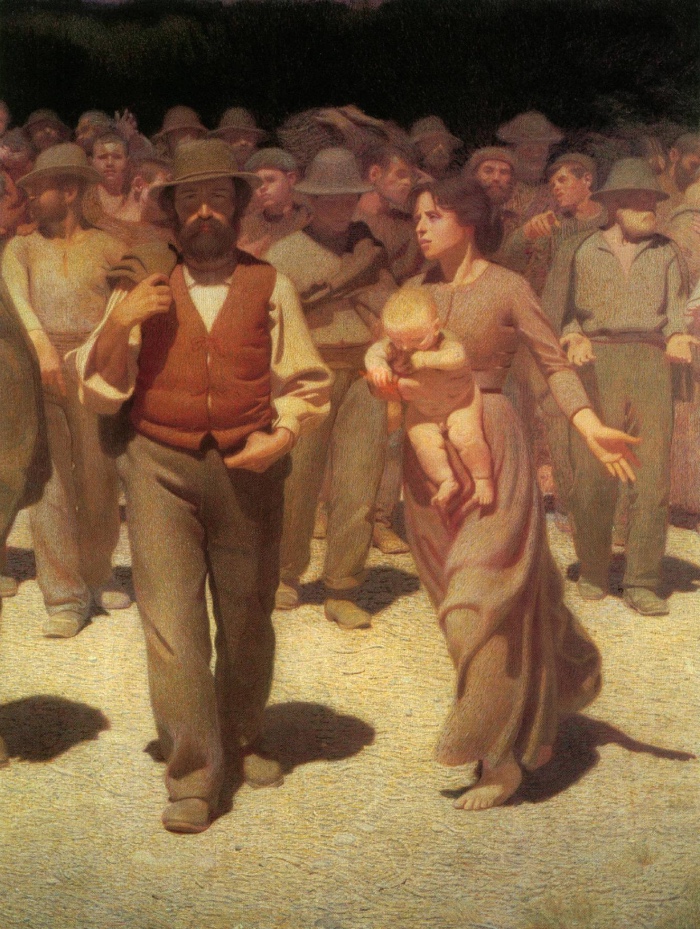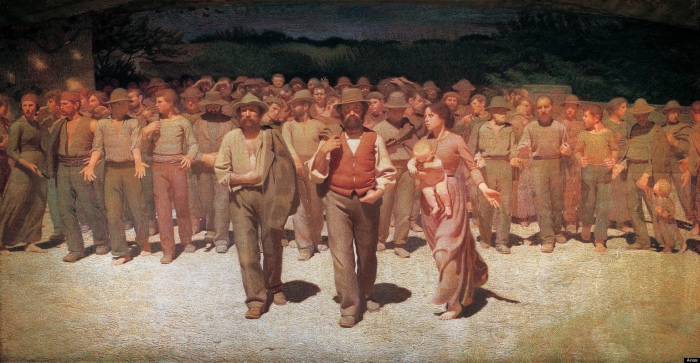
Image source: Wikipedia.org
THE FOURTH STATE: WHERE IT IS AND WHAT IT REPRESENTS
The Fourth Estate is the result of a long journey by Giuseppe Pellizza da Volpedo, who for the first time in the history of Italian art represents the rise of the labour movement in the social life of the country and does so as if it were inevitable.
The work is kept in Milan and I recommend you go and see it as soon as you can because Giuseppe Pellizza da Volpedo, an exponent of the pointillist movement, presented The Fourth Estate at the Quadriennale in Turin in 1902 and it has since become a symbol of the workers’ struggle.
The work was actually originally entitled The Workers’ Way, but at the last moment the artist decided to change it to what we all know today.

Image source: Rai.it
The Fourth Estate is the symbol of an era and an entire social class.
WHAT THE FOURTH STATE REPRESENTS
The subject is a strike, but instead of depicting a scene of violent clashes, which other artists had already depicted, Giuseppe Pellizza da Volpedo decides to show the slow parade of workers, advancing towards the viewer.
For the first time in the history of Italian art, an artist chose to represent the rise of the workers’ movement in the social life of the country and did so as if it were inevitable.
For many today, this painting may seem rhetorical, but in reality we must not forget that in the late 19th and early 20th century, the social question was a theme with which an artist had to (and wanted to) measure himself.
Those were years of great change and the principle of the emancipation of the people, seen as the necessary prerequisite for a better future, was asserting itself.
The Fourth Estate represents a group advancing frontally, led by three figures in the foreground: two men and a woman holding a child.
Giuseppe Pellizza da Volpedo studied at length the positioning of the hands, feet, the structure of the shadows and the orientation of the heads to give the entire composition the feeling of a compact group moving towards the viewer, who feels an active part of the scene.
THE FOURTH STATE: ANALYSIS
The idea for this work was born in Giuseppe Pellizza da Volpedo’s mind several years earlier.
He started work on the subject in 1895, but it would take him six years to complete the work and in the meantime there would be two other small paintings, very similar to The Fourth Estate and which can be considered part of the elaboration of the final work.
These are Ambassadors of Hunger (1891-1892) and Fiumana (1895 -1896).
No buildings are depicted in the background and this isolates the event in an ideal moment, which becomes the symbol of the workers’ journey towards the future.
In reality, Giuseppe Pellizza da Volpedo notes in his documents a precise location for the scene, Piazza Castello in Volpedo (the town in the province of Alessandria where the artist was born).
The point of view chosen by the painter is minutely annotated and does not change throughout the various re-elaborations of the painting, despite the fact that he does not include any element that would allow the exact location to be identified just by observing the painting.
More than a century later, admiring The Fourth Estate is always necessary, so as not to forget that the right to work was an arduous and not taken for granted conquest, that there was a time when society was divided into social classes and not everyone had the same opportunities.
This work reminds me that there was a time, not too long ago, when artists described the lives of men and women so that the memory of their ideas and ideals would not be erased.
“The Fourth Estate is a social painting representing the most salient fact of our time, the fatal advance of the workers” – Giuseppe Pellizza da Volpedo

Image source: Rai.it (dettaglio)
THE FOURTH STATE WHERE IT IS EXHIBITED
The canvas was purchased in 1920 by the City of Milan through a public subscription and is now on display at the Museo del Novecento.
The Museo del Novecento in Milan’s Piazza Duomo has kept and exhibited the Fourth Estate for many years.
After much controversy and some reflection, the canvas was placed in the Galleria d’Arte Moderna (GAM), between the rooms dedicated to Giovanni Segantini and Previati.
The new location was designed to enhance the viewing of this monumental work.
THE FOURTH ESTATE ON EXHIBITION
The Fourth Estate is rarely loaned for an exhibition.
It happened about 14 years ago for a loan to the Scuderie del Quirinale, but now it has finally been moved from Milan to Florence.
The canvas was on display from 1 May to 30 June 2022, free of charge, in the Salone dei Cinquecento in Palazzo Vecchio, Florence.
Not a few controversies preceded the canvas’ journey from Milan to Florence.
The Fourth Estate has a strong bond with the city of Milan, which acquired it for 50,000 lire in 1920 thanks to a popular subscription (i.e. thanks to citizens’ donations) and kept it in the Sala della Balla in the Castello Sforzesco.
Exhibited after the Second World War in the Council Chamber of Palazzo Marino, it was first moved to the Gallery of Modern Art in 1980, and then in 2010 to the Museo del Novecento.
However, the exhibition in Milan was an opportunity to rethink its location: the niche where it had been placed in the Museo del Novecento, under a spiral staircase and before the permanent collection, was not very well lit, and during the stay in Florence, a suitable room was set up to house the canvas.


E’ veramente sorprendente trovare a commento di questo quadro una simile frase:
“A distanza di più di un secolo, ammirare Il Quarto Stato è sempre necessario, per non dimenticare che il diritto al lavoro è stata una conquista faticosa e non scontata, che ci fu un tempo in cui la società era divisa in classi sociali e non tutti avevano le stesse opportunità”.
Per chi ha scritto questo commento, sembra che una volta la società era divisa in classi, ma oggi no! Che una volta non tutti avevano le stesse opportunità, ma oggi sì!
Beata ingenuità!
Sarò anche ingenua, ma non si può paragonare il XXI secolo (in cui viviamo) con l’inizio del ‘900.
Il mondo e la società erano completamente diversi e non c’era speranza di diventare un medico, un avvocato, un libero professionista se nascevi in una famiglia di operai oppure di contadini.
Le donne poi non potevano immaginare di lavorare, avere una famiglia e contemporaneamente seguire i propri sogni.
No, non siamo più divisi in classi, perché ora un ragazzo magrebino di 17 anni può pensare di percorrere, con tutte le difficoltà e i pericoli, la strada che lo porterà in Europa e una volta arrivato può anche provare a studiare per diventare ciò che desidera.
Certo, non è facile, certo rischia la vita, certo sarò discriminato.
Oggi come ai primi del ‘900 la vita non è mai facile, ma almeno quel ragazzo può “sperare” ed è la speranza che il futuro possa cambiare e possa essere diverso a determinare il destino dell’uomo.
Nel dipinto di Pelizza da Volpedo c’è la speranza di un popolo, fatto di uomini e donne e bambini, che tenta di prendere in mano la propria vita e il proprio futuro e lotta perché nessuno pensi o tenti di fare in modo che la vita di un essere umano sia già segnata.
Concordo in pieno con te Caterina!
Grazie. La cosa interessante è che un’opera come questa riesca ancora a scatenare tante idee contrastanti. E’ la forza dei veri capolavori!
Pensi a quando Berlusconi disse: questi vogliono equipare il figlio del professionista con il figlio dell’operaio: https://www.youtube.com/watch?v=OifR7dXBxfw
Un’opera stupenda sia per lo stile che per il suo profondo significato. Ricordo quando la vidi per la prima volta al Museo del Novecento, un effetto incredibile!
Vero, fa sempre un certo effetto quest’opera. Ha un messaggio potente!
Mio padre era macchinista in un idrovora e le idrovore erano situate in mezzo alle campagne bonificate. Nella parete dell’ingresso di casa mia, attaccata all’idrovora, campeggiava una riproduzione a grandezza naturale del quadro di Pelizza da Volpedo. Negli anni 50, quando io sono nato, i miei vicini di casa, erano gli stessi rappresentati nel quadro, ma 50 anni dopo. E non c’era differenza, erano ancora in marcia. E oggi, dopo altri 50 anni, ho l’impressione che quel popolo in marcia abbia perso di vista l’obiettivo e non conosca la speranza. Adesso il Pelizza dovrebbe sostituire quei contadini con i migranti africani….
In ogni caso, quando guardo quel quadro, mi riconosco nelle mie radici e riesco sempre a emozionarmi.
Il mondo è cambiato, e tanto, da quando Pelizza da Volpedo dipinse l’opera. Io in quel popolo in marcia ci vedo tanti ragazzi che vanno all’estero per prendersi il loro posto nel mondo e che in Italia non trovano.
Ci vedo tanti amici che lavorano a Londra o negli Stati Uniti, che sono partiti per realizzare i loro sogni e che la speranza non l’hanno persa, ma hanno capito che c’è un momento in cui devi alzarti e partire per migliorare questo mondo e la tua vita.
Estou estudando este quadro para discutir com meus alunos as diferenças entre ele e os movimentos dos trabalhadores aqui no Brasil.
Very interesting 🙂
muito Obrigada. Tu entendes português?
Colocarei o meu site para que o entendas
No, I do not understand Portuguese, but Google translate helps 😉
E un quadro che esprime una necessita di unirsi in un cammino che sara sicuramente duro e pieno di ostacoli,
Interessante e guardare lo sguardo dei personaggi che si confondono e si incrociano costruendo istante per istante un unico solo volto che prende come per magia tutto lo spazio della tela.